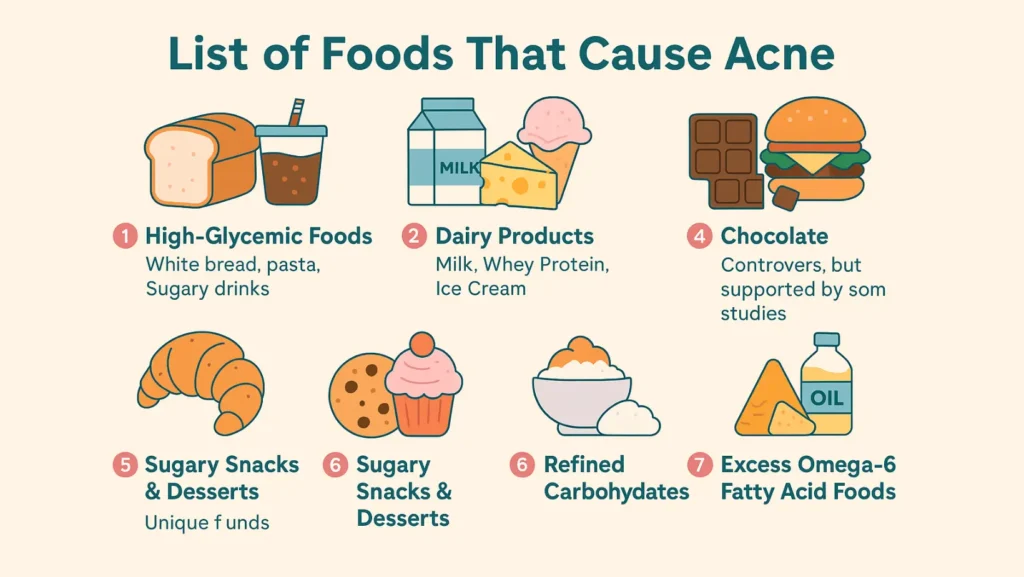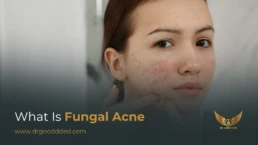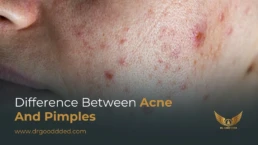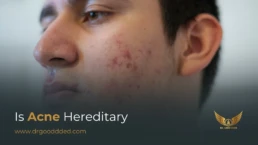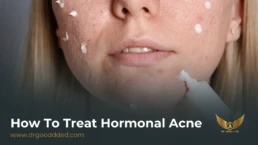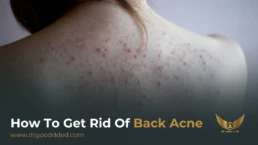Foods can cause acne in many people because certain meals can change hormones, raise skin oil, and increase inflammation. Your skin reacts to these internal shifts, which means a plate of food can set off breakouts more than you expect.
Table of Contents
ToggleSome foods raise blood sugar fast, some push hormone spikes, and others irritate the body from the inside. When these effects combine, pores clog more easily and pimples form faster. You can reduce this reaction when you learn which foods act as triggers and how they influence your skin in daily life.
Food That Causes Acne Breakouts
Foods that cause acne often share traits. They raise blood sugar fast. They also change hormones that control oil. When oil rises, pores can block. Blocked pores let bacteria grow. That leads to red bumps and whiteheads. You can use diet to cut some of these steps.
How Diet Influences Hormones And Oil Production
When you eat sugar or refined carbs, your blood sugar spikes. Your body then releases insulin. Insulin tells the body to make more IGF-1. IGF-1 is a growth signal. It makes the oil glands work harder. More oil means more chance of clogged pores. Foods that raise insulin often act like foods that cause acne. You will notice flare-ups after sugary meals if your skin reacts to diet.
The Role Of Insulin Spikes In Acne Flare-Ups
Insulin spikes come after sweet drinks and white bread. Each spike pushes hormones toward oil production. If you have many spikes in a day, the oil glands stay active. This creates a steady state that favors pimples. That is why doctors study blood sugar and acne. High-glycemic meals are often listed in list of foods that cause acne for this reason.
Why Some People Are More Diet-Sensitive Than Others
You may react strongly to some foods. Genes play a role. Age also matters. Teenagers have stronger hormone swings. Your gut health can change inflammation. Some people have skin that reacts to small hormone shifts.
If you combine genetics with a sugary diet, you may be more likely to see breakouts. This is why not everyone who eats the same food gets the same reaction.
List Of Foods That Cause Acne
Below is a clear list of common triggers. Try reducing these foods for weeks. Watch your skin for change.
1. High-Glycemic Foods (White Bread, Pasta, Sugary Drinks)
High-glycemic foods push blood sugar up fast. This causes insulin surges. Insulin surges increase oil and skin cell growth. Quick skin cell growth combines with oil. That clogs pores. Foods like white bread and soda appear in many studies as foods that cause acne. Swap to whole grains and vegetables to slow sugar release.
2. Dairy Products – Milk, Whey Protein, Ice Cream
Milk contains hormones that raise IGF-1. Whey protein can push insulin signals. Many studies link milk to more pimples. You may find acne improvement when you cut milk. Ice cream adds sugar and dairy. That combo can act like a double trigger. For athletes, watch whey powders. They can cause sudden breakouts after use. For this reason, dairy is often on lists of acne-triggering foods.
3. Fast Food & Processed Meals
Fast food often mixes refined carbs with unhealthy fats. These meals also include hidden sugars. The result is insulin spikes and inflammation. Both feed acne. Frequent fast food intake matches worse skin in many surveys. If you want clearer skin, limit fast food and ready meals. Choose whole meals that keep blood sugar steady.
4. Chocolate (Controversial But Supported By Some Studies)
Chocolate shows mixed results in science. Pure dark chocolate may not harm skin for some people. Milk chocolate and candy bars add sugar and dairy. These added ingredients can cause breakouts in sensitive people. Controlled trials sometimes show more pimples after chocolate intake. Chocolate sits on many lists of foods that cause acne when it contains sugar or milk.
5. Sugary Snacks & Desserts
Snacks with sugar push insulin up repeatedly. Cookies, candies, and many desserts fit here. Repeated insulin spikes keep oil glands active. That supports pore blockage over time. Reducing snack sugar often lowers new pimples for many people. This group is a core part of list of foods that cause acne.
6. Refined Carbohydrates
White rice, pastries, and many snack foods behave like sugar. They cause similar hormone shifts and inflammation. These items often hide in meals. They can add up to many insulin spikes each day. That steady assault favors acne.
7. Excess Omega-6 Fatty Acid Foods
Foods high in omega-6 fats include some vegetable oils and processed snacks. Too much omega-6 can raise inflammation. Inflammation worsens red and painful pimples. Balancing omega-6 with omega-3 is helpful. Add fish, flax seeds, and chia to lower inflammation.
Acne-Triggering Foods Explained
This section explains how the items above act inside your body. You will get clear reasons you can test at home.
Why Dairy May Worsen Acne
Milk has natural hormones. It also raises IGF-1 levels in your blood. These changes push oil gland activity. Yogurt and cheese vary in effect. Some fermented dairy may cause fewer issues. Still, many people report better skin after cutting milk for weeks. That makes dairy a common item among acne-triggering foods.
Why High-Glycemic Foods Spike Breakouts
High-glycemic items cause fast sugar rises. Your body responds with insulin. Insulin raises androgens and IGF-1. Those hormones increase oil and skin cell growth. Excess skin cells and oil block pores. This chain explains why foods that cause acne often include sugary and refined items.
Link Between Inflammatory Fats And Acne
Healthy and unhealthy fats behave differently. Omega-3 fats lower inflammation. Omega-6 fats raise it when too high. Many processed foods contain unhealthy fats. These fats raise inflammatory markers. Red skin and painful pimples relate to this inflammation. This is why fat type matters for acne risk.
Supplements That Can Trigger Acne (B12, Whey Protein)
Some vitamins and powders can change skin balance. High vitamin B12 may alter skin bacteria. Whey protein can raise insulin signals. If you start a new supplement and then get acne, consider stopping it. Track changes for three weeks to see a clear pattern.
Oily Foods And Acne: Myth Vs Reality
Does Eating Oily Food Actually Cause Acne?
You eating greasy food does not directly plug your pores. Oil you eat goes through digestion. Your skin oil comes from glands under the skin. Still, greasy meals often include sugar and refined carbs. Those ingredients raise insulin and inflammation. That process can lead to breakouts.
If you eat fries with sugary drinks, both parts can increase acne risk. Many people blame grease alone. The real issue is the meal pattern and ingredients that act like foods that cause acne.
Why Greasy Food Is Blamed For Acne
You see a shiny face after a heavy meal and assume cause. That feeling makes the greasy food suspect. Social habit and tradition reinforce that blame. Often the meal has sugar, dairy, and refined carbs. Those items change hormones.
Hormone change can raise oil and inflammation. That sequence creates pimples. So greasy food gets blamed more than it deserves. For clarity, learn which ingredients are the real culprits among foods that cause acne.
Difference Between Oil On Skin Vs Oil In Diet
Oil on the skin sits in pores and blocks them. Dietary oil goes into the gut. The body processes it into energy or fat. What changes skin oil is hormone signals. Some foods change hormones more than others. These hormone changes cause glands to produce oil.
You must separate the two ideas. The oil you eat is not the same as the oil that clogs pores. Yet diet can change oil production indirectly through hormone shifts tied to foods that cause acne.
Diet And Acne Connection
Scientific Evidence Supporting Diet-Related Acne
Clinical trials link high-glycemic diets to worse acne. Multiple studies show dairy links to increased pimples. Randomized trials that lower glycemic load often reduce acne. Observational research finds consistent links across ages. Not every study shows the same size effect.
Still, overall evidence supports diet as a factor. You can use diet change as a low-risk method to test impact. This evidence highlights which acne-triggering foods to watch.
Hormonal Impact Of Food Choices
Food choices change insulin and IGF-1 levels. These hormones control oil glands. When insulin rises, androgens can rise too. That combination drives oil and skin cell growth. More oil and cells equal more clogging.
Reducing foods that spike these hormones often lowers oil levels. You will notice smoother skin if you lower those triggers among foods that cause acne.
How Inflammation Links Diet To Breakouts
Some foods raise body inflammation. Inflammation makes pimples red and painful. Omega-6 heavy diets increase inflammatory signals. Sugar and processed fats also fuel inflammation.
Fighting inflammation helps reduce acne severity. Foods that lower inflammation often ease skin symptoms. That is why anti-inflammatory food choices matter in the diet and acne connection.
Diet Patterns That Improve Acne
Follow a pattern that reduces insulin spikes and inflammation. Eat whole grains, vegetables, and lean protein. Choose low-glycemic carbs. Add omega-3 rich foods such as fish and seeds. Limit dairy if you suspect a reaction.
Avoid processed snacks and sugary drinks. These patterns help many people see fewer breakouts. They also reduce risk from common acne-triggering foods.
Foods That Help Improve Acne
Low-Glycemic Foods (Whole Grains, Vegetables)
Low-glycemic foods raise blood sugar slowly. They prevent large insulin surges. Whole grains and most vegetables fit here. You will get longer satiety and steadier hormones. That steady state lowers oil gland stimulation.
Replace white bread with whole grain options to test the change. These swaps reduce exposure to foods that cause acne.
Anti-Inflammatory Foods (Omega-3, Turmeric)
Omega-3 fats in salmon and flax reduce inflammation. Turmeric contains curcumin. Curcumin lowers inflammatory markers. These foods calm skin redness and swelling. Add them to meals several times per week. They act against the inflammatory part of acne. They help counteract the effects of acne-triggering foods.
High-Fiber Foods
Fiber slows digestion and lowers sugar spikes. It helps the gut bacteria that support good metabolism. Beans, fruits, and whole grains give fiber. Fiber also helps balance hormones by slowing sugar absorption. Eating fiber helps reduce exposure to the insulin effects behind foods that cause acne.
Hydrating Foods + Antioxidants
Hydrating foods hold water in the skin. Antioxidants fight damage from inflammation. Berries, leafy greens, and cucumbers help skin repair. They support healing and reduce redness. Drink water and include hydrating produce daily. This supports skin while you reduce foods that cause acne.
How To Identify Your Personal Acne Food Triggers
Keep A 14-Day Food Diary
Write daily meals and snacks. Note the time you eat. Note skin changes each evening. Use simple checkboxes for new pimples. After two weeks, search for patterns. You will spot repeat offenders. This method helps you find which foods that cause acne affect you.
Elimination Diet For Acne
Remove one suspect food for three weeks. Only remove one item at a time. Track your skin often. If skin improves, add the food back. If acne returns, you found a trigger. Common trials remove dairy or sugar first. This method isolates personal responses to acne-triggering foods.
How To Track Skin Response After Meals
Take daily photos in the same light and position. Record the date and meals. Rate your skin redness and new pimples on a simple scale. Compare week to week. Changes tied to specific foods become clearer. This practical tracking shows the role of foods that cause acne in your routine.
When To Get A Nutrition Or Dermatology Consult
If acne is severe, seek a dermatologist. If diet change hurts your nutrition, see a dietitian. Professionals help you test safely. They can order lab tests or prescribe medicine. Consult when home tests do not help. Professional input speeds diagnosis and safe treatment for any diet-related acne.
FAQs
Does Dairy Really Cause Acne?
Dairy can raise IGF-1 and hormones that increase oil production. Some people show clearer skin after cutting milk. Try removing dairy for three weeks to test whether foods that cause acne include milk for you.
Does Chocolate Cause Acne Breakouts?
Chocolate with sugar and milk may trigger breakouts in sensitive people. Pure dark chocolate often causes fewer problems. Watch your skin after chocolate to check its role among acne-triggering foods.
Are Oily Foods And Acne Connected?
Greasy food itself does not plug pores. The real link is the meal’s sugar and refined carbs. These raise insulin and inflammation and then skin oil. That pattern ties greasy meals to foods that cause acne indirectly.
Can I Prevent Acne Through Diet Changes?
You can reduce acne by lowering high-glycemic and inflammatory foods. Eat whole foods, more vegetables, and omega-3 sources. These steps lower hormone spikes tied to food that causes acne breakouts.
Does Drinking More Water Help Clear Acne?
Water supports skin healing and hydration. It does not cure acne by itself. Use water along with dietary changes and skin care to reduce the impact of foods that cause acne.
Is Acne Caused By Food Allergies?
Food allergies cause hives or swelling, not classic acne. Acne links more to hormones and inflammation than allergy. If you suspect allergy, get testing before removing key foods tied to foods that cause acne.
Can Coffee Worsen Acne?
Black coffee affects people less. Coffee drinks with sugar and cream can raise insulin. If your coffee habit includes sweeteners, it may worsen pimples. Track the drink’s ingredients in your food diary to see the effect among foods that cause acne.
Are Vegan Diets Better For Acne?
A vegan diet can help if it reduces dairy and processed foods. If it includes many refined carbs and sweets, it may still worsen acne. Focus on whole plant foods to avoid foods that cause acne.

This article is medically reviewed by Dr. Nivedita Pandey, Senior Gastroenterologist and Hepatologist, ensuring accurate and reliable health information.
Dr. Nivedita Pandey is a U.S.-trained gastroenterologist specializing in pre and post-liver transplant care, as well as managing chronic gastrointestinal disorders. Known for her compassionate and patient-centered approach, Dr. Pandey is dedicated to delivering the highest quality of care to each patient.

